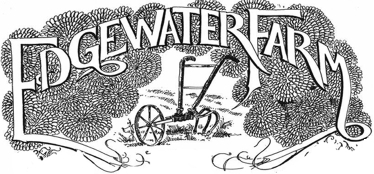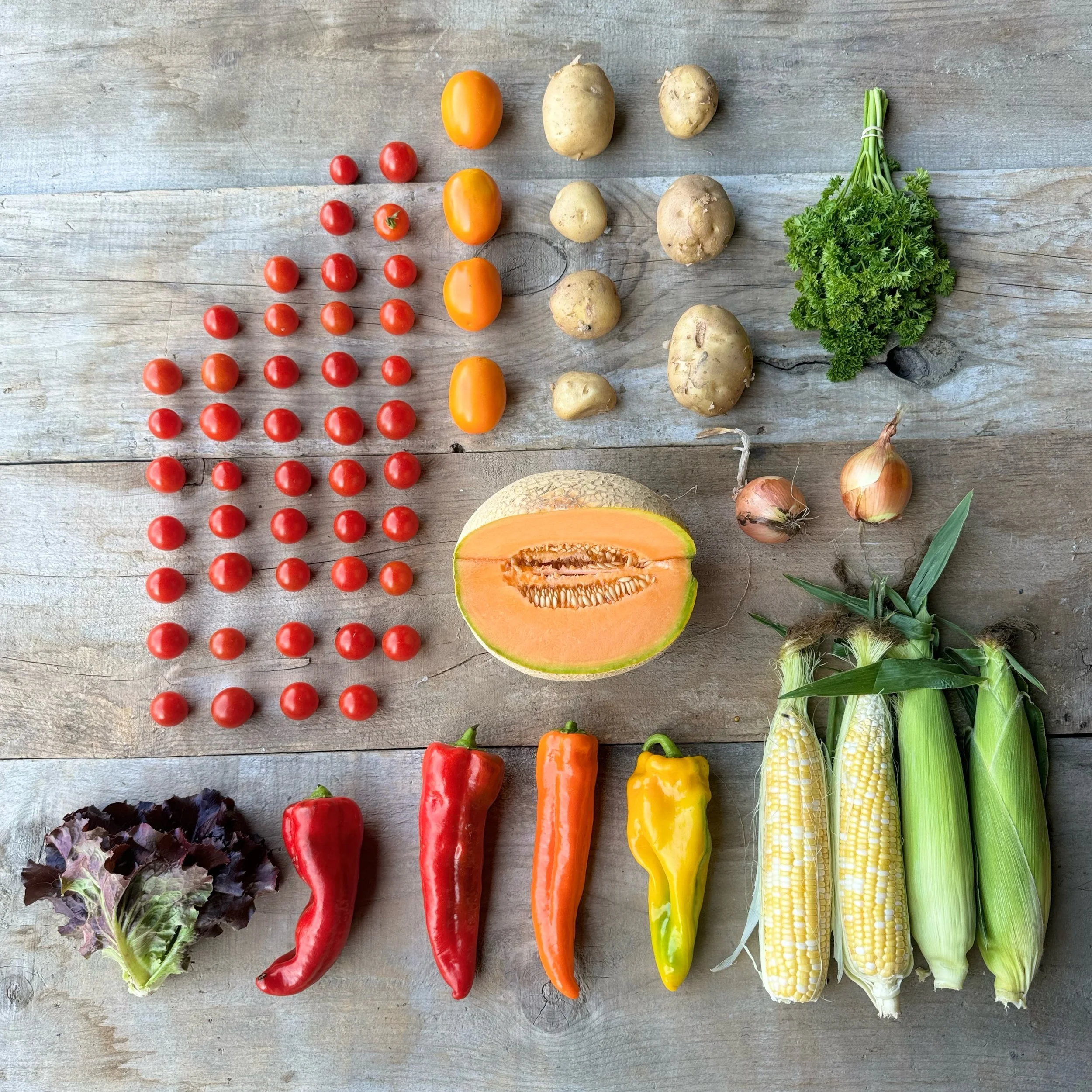P i c k l i s t
CARMEN PEPPERS GALORE - CHERRY TOMATOES - GOLDEN PLUM TOMATOES - CURLEY PARSLEY - POTATOES! - CORN - MELON - LETTUCE - ONIONS -
Edgewater update: Holy smokes it appears last week’s practice in collective thought worked! Granted the rain came on Wednesday afternoon around 5:30 and not the proposed 11:11am on Thursday morning, but still, all our minds were on rain, and hot diggity dog we made it happen! Unfortunately, since then, the fields are back to dry- but hopefully that bit of rain will carry us through until the next shower.
As far as Edgewater updates go, we are ALL still coming down from that Cornish fair high. After being TOTALLY INSPIRED, by the “funny vegetable” competition our brains have shifted toward Tunbridge fair and now we are all in search of the ideal funny crop to enter. We’ve all seen a carrot with 5 legs, but what about an eggplant with a bouffant and a nose? Or an English cucumber the length of an adult leg? This year at the fair, Ray judged the vegetables, and I entered what I believed was a masterpiece of a bouquet. Unfortunately the judges did not agree with my unparalleled whimsy, but so it goes. I suppose not everyone loves a cascading amaranth or a dinner plate dahlia. As it turns out I am a real sore loser. Better luck next year! One highlight was seeing our farmstand’s Sara get snazzy in that crisp 4-H white and show her cow. Such a cool skill!
Back to reality for all of us this Monday as we officially called it on blueberry season. But wow what a go! 6 weeks of picking is a huge success for us. The end of bluebs marks many things for us this year. It is the time we shift from lighter harvests to literal mass poundage. From here forth we will start to fill crates with all the heavy goods- melons, beets, potatoes, winter squash, etc.
This blueberry finale also coincides with the college kids heading back to school. One college kid in particular gave it her all this season on the field crew. Cardigan Loupis is a total inspiration. This year was her third season on field crew and every year she farms with us she gains more and more of that edgewater knowledge. She goes with the flow and for that we are grateful. Three cheers to Cardi!
Lastly, our 2025 onion harvest has come and gone. The onions are picked and are currently drying out on greenhouse benches As we creep towards the Fall equinox, weed pressure in the fields is starting to slow its roll. Hooray for that!
But DO NOT BE FOOLED BY THIS COLD SNAP! It is in fact still summer, and the watermelon is just about ready.
FARMY FOODIE PRO-TIPS:
hooray to Mitchell Davis, who graciously puts together recipes every week to complement your CSA. The past two days I texted him (what felt like) 1000 times about all the changes in the pick list. Serves me right for thinking anything is official the day before harvest. Lesson learned. So for any of you, wishing for a CSA list of veg anytime before Wednesday morning, forget it. Totally impossible when crops literally change on you overnight. But I digress, read on for Mitchell’s recipes and if you are curious about alllll the recipes he has to offer, see his substack:
Maple Dijon Vinaigrette
Makes a little more than a cup of dressing.
This dressing is perfect for any bitter greens. (RED LETTUCE THIS ONE’S FOR YOU!)
2 tablespoons Dijon mustard
2 tablespoons maple syrup
Pinch salt
1/2 teaspoon sweet or smoked paprika
1/4 cup white or red wine vinegar
About 2/3 cup extra-virgin olive oil
1 small shallot, minced (optional)
In a small bowl, whisk together the mustard, maple syrup, salt, paprika, and vinegar until combined. While whisking vigorously, slowly drizzle in the olive oil to make a nice emulsion. If the dressing gets too thick or is a little too strong to your taste, whisk in a tablespoon of warm water. Stir in the minced shallot, if using. The dressing will keep covered at room temperature for several days. Whisk before using.
Tabbouleh
Makes 2 to 4 side-dish servings
Although we’ve come to think of tabbouleh as a bulgur salad seasoned with parsley, in fact in the Middle East it’s traditionally a parsley salad with a little bulgur in it. I like to make it with curly parsley (and some mint if you have it) because it holds its texture better than flat-leaf parsley as the tabbouleh sits.
1/4 cup fine bulgur
1 bunch curly parsley, chopped
About 20 mint leaves, or an additional bunch of parsley
2 medium ripe tomatoes, finely diced
1/2 small Kirby or 3-inch piece of English cucumber, seeded, peeled and finely diced (optional)
2 scallions or 1 tablespoon red onion, finely diced
Juice of 1 lemon, about 4 tablespoons
1/3 cup extra-virgin olive oil
Salt and pepper to taste
Rinse the bulgur under cold water to remove any starch. Drain and place in a mixing bowl. Add the chopped parsley, chopped mint, tomatoes (and any juice that escaped from them), cucumber, if using, scallion, lemon juice, olive oil, a pinch of salt, and some freshly ground black pepper. Stir to mix well. Let sit at room temperature for 15 to 20 minutes for the bulgur to absorb the liquid and soften. Toss, taste, adjust the seasoning, and serve.
Fermented Pepper Sauce
This time of year, when both sweet and hot peppers are abundant, I like to prepare a few batches of lacto-feremented pepper sauce to eat throughout the winter. Keep similar color peppers together (greens with greens, reds with reds) for the best-looking results.
Kosher salt
Filtered water
Fresh red and green peppers, sweet and/or hot, stems removed and seeded
Garlic cloves
Begin by dissolving the kosher salt into the filtered water to make a 3% to 4% salt solution. You’ll need just enough to fill your jars, so it depends on how many peppers you have. As a guideline, use 1 generous tablespoon of salt per cup of water, which extends to 1/4 cup salt per quart. To dissolve the salt, you may need to the heat water and stir until you no longer see any salt granules. Allow the water to cool fully to room temperature before continuing. Pack like-colored peppers in sterilized mason jars along with the garlic. I use 1 medium clove of garlic per pint jar of peppers. Pack tightly and be sure to tuck the peppers under the shoulder of the jar so they stay submerged in the salt solution. None should pop above the brine. Fill the jars to just below the rim with the salt solution. Stretch some cheesecloth or muslin over the top of the jar and secure with an elastic band. Let sit in a dark place at room temperature for about 5 days, until there is evidence of good fermentation, e.g., some bubbles on the surface,
cloudy water, and a strong smell of pepper and garlic. I like to ferment my peppers well, to develop the flavor, so even when I think they might be done, I go another day or two. If it is very warm, as it has been lately, they will ferment faster. If you sense any off flavors, such as mold or mildew, you may have to start again.
When you are satisfied with the fermentation—you can taste the brine for tanginess and flavor—pour the contents of the jar(s) into a powerful blender and pulse and purée until smooth. Taste and adjust the seasoning. Pack into clean jars, cover tightly and refrigerate for up to six months.

